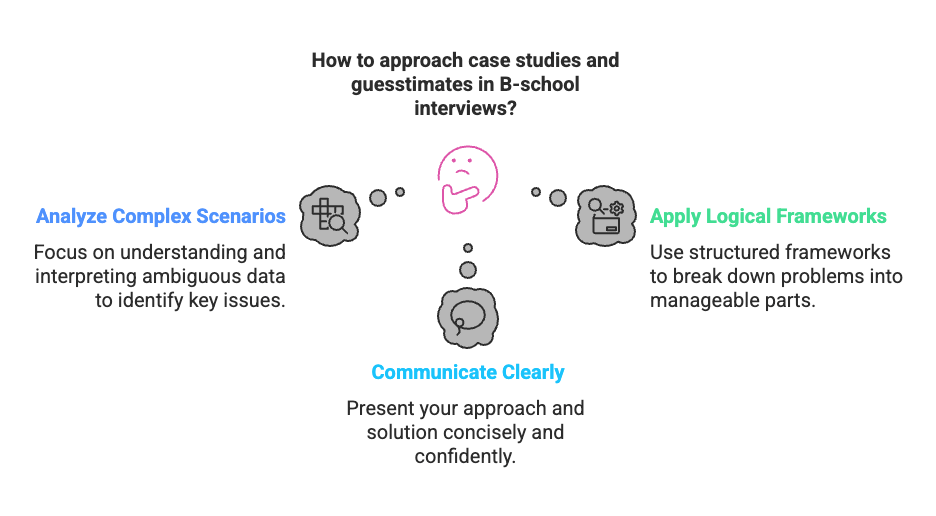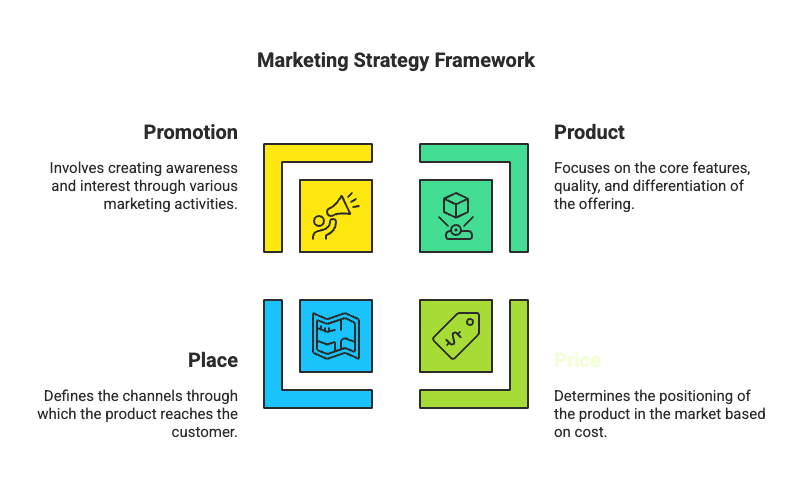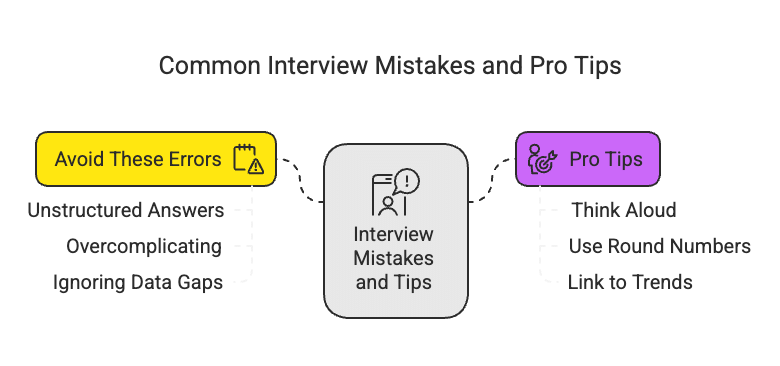Case Studies and Guesstimates: A Strategic Guide for CAT Interviews | CAT Interview Preparation Guide PDF Download
| Table of contents |

|
| Essential Frameworks |

|
| Market-Sizing Guesstimates |

|
| Mock Case Study – Profitability Decline |

|
| Common Mistakes & Tips |

|
| Key Takeaways |

|
Top B-schools like the IIMs often use case studies and guesstimates during interviews to assess your structured thinking, problem-solving ability, and decision-making under constraints. These exercises are designed to simulate real-world business situations and test how you:
Analyse complex scenarios with limited or ambiguous data
Apply logical frameworks (like MECE, SWOT, 4Ps, etc.) to break problems into manageable parts
Communicate your approach and solution clearly, confidently, and concisely
They’re less about getting the “right” answer and more about showing how you think. Clarity, structure, and presence of mind matter more than flashy jargon or speed.

Essential Frameworks
Top B-schools expect candidates to approach problems methodically. Here are three must-know frameworks that help bring structure and depth to your answers:
1. MECE (Mutually Exclusive, Collectively Exhaustive)
MECE is a way to break down complex problems into clear and organized parts.
Mutually Exclusive means each part should be different — no overlaps.
Collectively Exhaustive means together, all parts should cover the whole problem — nothing left out.
This method helps avoid confusion, repetition, or missing key details — which is why it’s great for interviews, especially case studies and guesstimates.
Why it matters:
In interviews (especially case studies and guesstimates), MECE helps you present your thinking in a structured, comprehensive, and logical way. It’s a key skill that B-school panellists look for to assess how well you can analyse and approach real-world problems.
Example 1: Estimate the number of smartphone users in India.
Ans: Breakdown using MECE:
Geography: Urban vs. Rural
Age groups: 18–30, 31–50, 51+
Income segments: High, Middle, Low
You can multiply estimates across these categories to structure your assumptions clearly.
Example 2: Estimate annual laptop sales in India.
Ans: Breakdown using MECE:
User Segments: Students (30%), Professionals (50%), Others (20%).
Price Brackets: Budget (<₹30k), Mid-range (₹30k–₹60k), Premium (>₹60k).
Sales Channels: Online (60%), Offline (40%).
Calculation:
Total population = 1.4B → Urban (35%) = 490M → Target age (18–45) = 40% = 196M.
Assuming 5% annual purchase rate: 196M × 5% = 9.8M laptops sold annually.
2. Porter’s Five Forces
What it is:
A strategic tool used to analyse the competitive environment of an industry. It helps you understand why a company might be losing profits or struggling with market share.
The Five Forces Explained:
1. Threat of New Entrants
Are new players likely to enter the market easily?
High threat = lower profits for existing firms.
Example: Low capital requirement and no regulation make it easier for startups.
2. Bargaining Power of Suppliers
Do suppliers have control over price and quality of inputs?
High power = companies must pay more or accept delays.
Example: Chip manufacturers during a semiconductor shortage.
3. Bargaining Power of Buyers
Can customers demand lower prices or better quality?
High power = lower margins for companies.
Example: Consumers switching easily to cheaper smartphone brands.
4. Threat of Substitutes
Are there alternative products solving the same need?
High threat = customers may shift, reducing demand.
Example: Online learning apps replacing offline coaching.
5. Industry Rivalry
How fierce is the competition between existing firms?
High rivalry = price wars, ad battles, shrinking profits.
Example: Telecom industry with Jio, Airtel, and Vi.
Case Study Application:
Example 1: Why is Company X’s profitability declining?
Ans:
Rivalry: Intense price wars are squeezing margins.
Substitutes: Consumers are switching to cheaper alternatives with similar features.
Example 2: Analyse the online education industry.
Ans:
Threat of New Entrants: High (low entry barriers, many EdTech startups).
Bargaining Power of Buyers: High (multiple platforms offering similar courses).
Substitutes: Traditional classrooms, free YouTube tutorials.
Supplier Power: Low (instructors are abundant; platforms dictate terms).
Industry Rivalry: Intense (Byju’s, Unacademy, Coursera compete on pricing/content).
3. 4Ps of Marketing
Use this framework to evaluate or design a product’s go-to-market strategy. It helps you think through the key components of marketing any offering:
Product: What are the core features, quality, and differentiation?
Price: Is it positioned as premium, mid-range, or budget?
Place: Through which channels will it reach the customer (online, retail, etc.)?
Promotion: How will you create awareness (ads, influencers, branding)?

Case Study Application:
Example 1:You're launching a new fitness app.
Product: AI-driven personalised workout plans and progress tracking.
Price: Freemium model — free basic access with paid premium features.
Place: Available on Android and iOS app stores.
Promotion: Collaborate with fitness influencers and run targeted social media ads.
Example 2: Launching an eco-friendly water bottle.
Product: Durable, BPA-free, made from recycled materials.
Price: Premium (₹999) to target eco-conscious millennials.
Place: Sold via e-commerce (Amazon, Flipkart) and eco-stores.
Promotion: Partner with environmental influencers; offer “Buy 1, Plant 1 Tree” campaigns.
Market-Sizing Guesstimates
Market-sizing (or guesstimates) tests your ability to make logical assumptions, break problems into parts, and arrive at a ballpark figure. Interviewers look for clarity, structure, and reasonable logic — not exact numbers.
Step-by-Step Template
1. Clarify the Question
Before jumping in, ask:
“Are we estimating annual demand, total users, or market value?”
“Should we focus on India as a whole or just urban areas?”
This ensures alignment and avoids misinterpretation.
2. Break Down Using MECE
Structure the problem using non-overlapping, exhaustive categories.
Example: Estimate the number of electric scooters sold annually in India.
Breakdown:
Total Population: ~1.4 billion
Urban Population (35%): ≈ 490 million
Adults (18–60, ~60% of urban): ≈ 294 million
Affordability (20% can afford electric scooters): ≈ 58.8 million
Adoption Rate (annual buyers = 5%): ≈ 2.94 million electric scooters
3. Anchor with Known Data
Use real-world figures to support your assumptions.
For example: “Industry reports show ~3 million electric scooters were sold in 2023” — this validates your approach.
EduRev Tip: Always end with a sanity check to compare your estimate with known market data, if available. It shows you're grounded in reality.
Example: Estimate the number of coffee shops in Mumbai.
Clarify: Focus on standalone cafes + chains (exclude roadside stalls).
Breakdown:
Mumbai population = 20M.
Assume 1 coffee shop per 10,000 people → 20M / 10,000 = 2,000 coffee shops.
Sanity Check: Zomato lists ~1,800 cafes in Mumbai → Estimate is reasonable.
Mock Case Study – Profitability Decline
Problem Statement:
TechGadgets Pvt. Ltd., a smartphone manufacturer, has experienced a 30% drop in profits over the last two years. Your task is to diagnose the root causes and suggest actionable solutions.
Approach: Structured Analysis Using Frameworks
1. Porter’s Five Forces
Industry Rivalry:
Fierce price competition from Chinese brands like Xiaomi and Realme.Buyer Power:
Consumers are highly price-sensitive and increasingly opting for more affordable alternatives.Supplier Power:
Global semiconductor shortages have driven up input costs, squeezing margins.
2. 4Ps Marketing Audit
Product:
Lacks differentiation; offers similar features as competitors with no standout value.Price:
Positioned at a premium despite offering comparable specs, perceived as overpriced.Place:
Available online and in retail, but no exclusive partnerships or bundling strategies.Promotion:
Low marketing spend compared to aggressive ad campaigns by competitors.
Recommendations
Product:
Introduce India-specific features (e.g., support for regional languages, better service coverage in Tier 2 & 3 cities).Price:
Shift focus to the value-for-money mid-range segment where demand is growing.Supply Chain:
Diversify component sourcing and improve forecasting to mitigate shortages and reduce costs.Promotion:
Increase brand visibility through influencer marketing and digital campaigns targeted at youth.
Common Mistakes & Tips
Avoid These Errors
Unstructured Answers: Jumping to conclusions without applying frameworks makes your response look disorganised.
Overcomplicating: Using excessive jargon or overly complex logic can confuse your interviewer. Stick to simple, clear reasoning.
Ignoring Data Gaps: Avoid assuming precision where there is none. Always state assumptions clearly to demonstrate logical thinking.
Pro Tips
Think Aloud: Interviewers want to understand your thought process. Instead of just providing the final answer, explain how you arrived at it.
Example: “Assuming India’s urban population is 35%, let’s calculate…”Use Round Numbers: Simplify calculations by rounding numbers for ease and speed.
Example: Use 1.5B instead of 1.4B for population estimates.Link to Trends: Relate your assumptions or conclusions to current trends or data.
Example: “Electric vehicle adoption in India is growing at a 40% CAGR, which could impact demand for scooters.”

Key Takeaways
Framework First: Always start with a clear structure like MECE, Porter’s Five Forces, or 4Ps to break down the problem systematically.
Clarify Assumptions: Be transparent about assumptions you’re making. For example: “I’m assuming a 5% annual adoption rate based on industry trends.”
Stay Calm: When faced with a complex problem, break it into smaller parts to avoid feeling overwhelmed. A clear step-by-step approach helps maintain focus.
|
21 videos|18 docs
|
FAQs on Case Studies and Guesstimates: A Strategic Guide for CAT Interviews - CAT Interview Preparation Guide
| 1. What are essential frameworks for market-sizing guesstimates in CAT interviews? |  |
| 2. How can I effectively analyze a case study involving profitability decline? |  |
| 3. What are common mistakes to avoid during CAT interviews? |  |
| 4. What tips can help improve performance in CAT interviews? |  |
| 5. What are the key takeaways from studying case studies and guesstimates for CAT preparation? |  |















